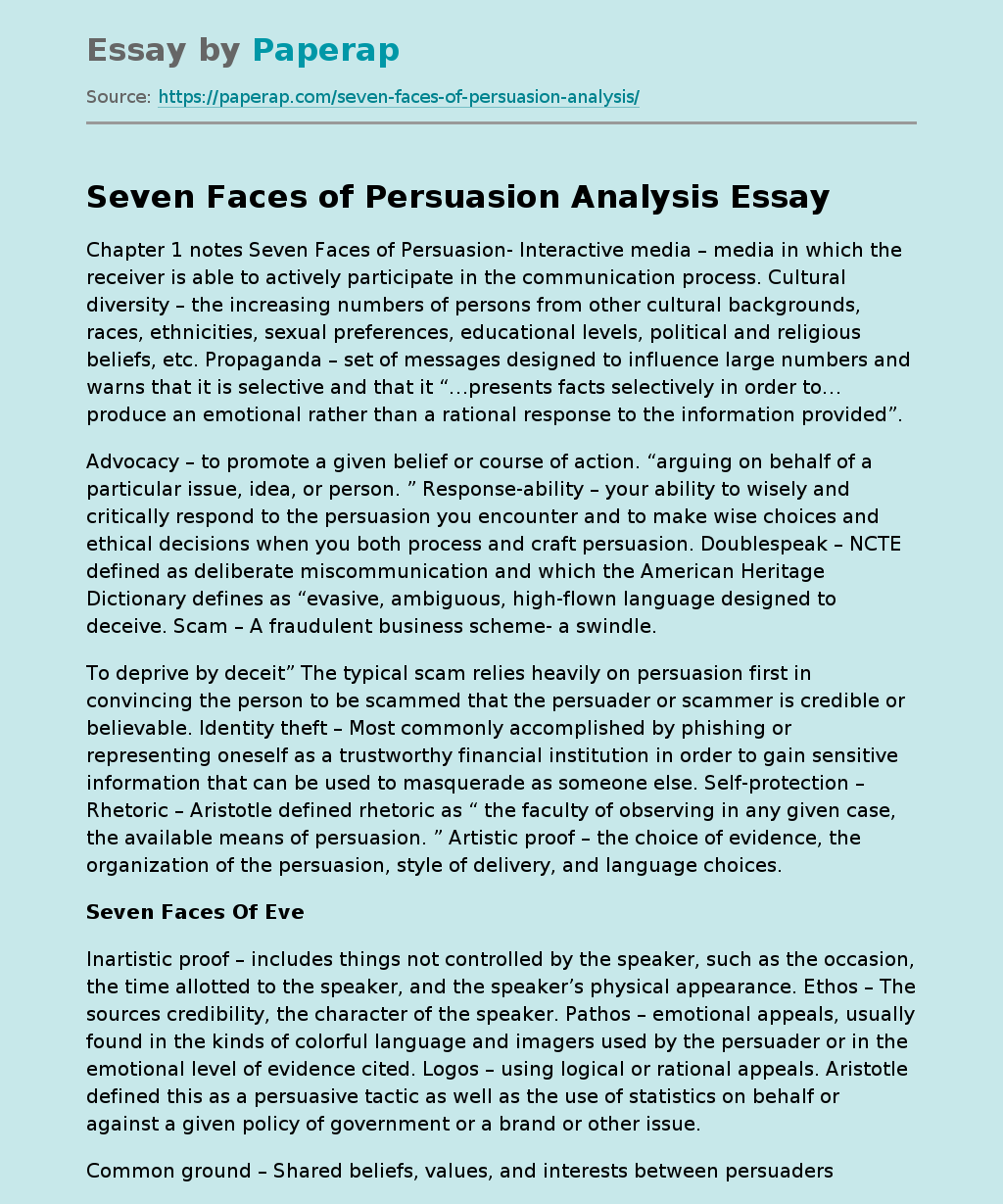Seven Faces of Persuasion Analysis
Chapter 1 notes Seven Faces of Persuasion- Interactive media – media in which the receiver is able to actively participate in the communication process. Cultural diversity – the increasing numbers of persons from other cultural backgrounds, races, ethnicities, sexual preferences, educational levels, political and religious beliefs, etc. Propaganda – set of messages designed to influence large numbers and warns that it is selective and that it “…presents facts selectively in order to…produce an emotional rather than a rational response to the information provided”.
Advocacy – to promote a given belief or course of action.
“arguing on behalf of a particular issue, idea, or person. ” Response-ability – your ability to wisely and critically respond to the persuasion you encounter and to make wise choices and ethical decisions when you both process and craft persuasion. Doublespeak – NCTE defined as deliberate miscommunication and which the American Heritage Dictionary defines as “evasive, ambiguous, high-flown language designed to deceive. Scam – A fraudulent business scheme- a swindle.
To deprive by deceit” The typical scam relies heavily on persuasion first in convincing the person to be scammed that the persuader or scammer is credible or believable.
Identity theft – Most commonly accomplished by phishing or representing oneself as a trustworthy financial institution in order to gain sensitive information that can be used to masquerade as someone else. Self-protection – Rhetoric – Aristotle defined rhetoric as “ the faculty of observing in any given case, the available means of persuasion. ” Artistic proof – the choice of evidence, the organization of the persuasion, style of delivery, and language choices.
Seven Faces Of Eve
Inartistic proof – includes things not controlled by the speaker, such as the occasion, the time allotted to the speaker, and the speaker’s physical appearance.
Ethos – The sources credibility, the character of the speaker. Pathos – emotional appeals, usually found in the kinds of colorful language and imagers used by the persuader or in the emotional level of evidence cited. Logos – using logical or rational appeals. Aristotle defined this as a persuasive tactic as well as the use of statistics on behalf or against a given policy of government or a brand or other issue.
Common ground – Shared beliefs, values, and interests between persuaders and persuades that could be established by all of the tactics. Enthymemes – defined as “ a form of argument in which the first or major premise in the proof remains unstated by the persuader and, instead, is suppli9ed by the audience. ” Identification – Burke believed that if receivers feel they are being spoken to in their “own language” and hear references to their own beliefs and values, they will develop a sense of identification with the persuader, believing that the persuader is like them.
Co-creation – this definition implies that persuasion requires intellectual and emotional participation between both persuader and persuade that leads to shared meaning and co—created identification. Self-persuasion – (ELM) Elaboration Likelihood Model – is a theory that serves as an organizational model of persuasions and has resulted in significant changes in the way theorists view persuasion. Central information processing route – one of two routes taken from the ELM, the receiver consciously and directly focuses on the persuasive communication while mentally elaborating on the issues and actively seeking more information.
This requires significant effort on the part of the receiver. Peripheral information processing route – one of two routes taken from the ELM, information may be processed almost instantly or just by the senses, without direct focusing on or researching of the decision. SMCR model : A source (S) (or persuader), who or which is the encoder of the message. The code can be verbal, nonverbal, visual, or musical, or in some other modality. A message (M), which is meant to convey the source’s meaning through any of the codes.
A channel (C), which carries the message and which might have distracting noise. A receiver (R) (or persuade), who decodes the message, trying to sift out channel noise and adding his or her own interpretation. Influence – refers to the ways in which some kinds of things alter a person’s attitude or behaviors. Coercion – another form of influence, always uses some level of force-physical or psychological- to gain compliance. Propaganda – is also another form of influence-usually psychological versus logical.
Hugh Rank’s model of persuasion – this gives four major persuasive strategies and six associated tactics frequently used by persuaders which critical receivers can identity. 1. Intensify their own good points 2. Intensify the weak points of the opposition 3. Downplay their own weak points 4. Downplay the good points of the opposition The six tactics are: Repetition, association and composition to intensify their own good points or the bad points of the opposition Omission, diversion, and confusion are used to downplay their own bad points or the good points of the opposing brands, candidates, causes, or ideologies.
Seven Faces of Persuasion Analysis. (2019, Dec 05). Retrieved from https://paperap.com/seven-faces-of-persuasion-analysis/

